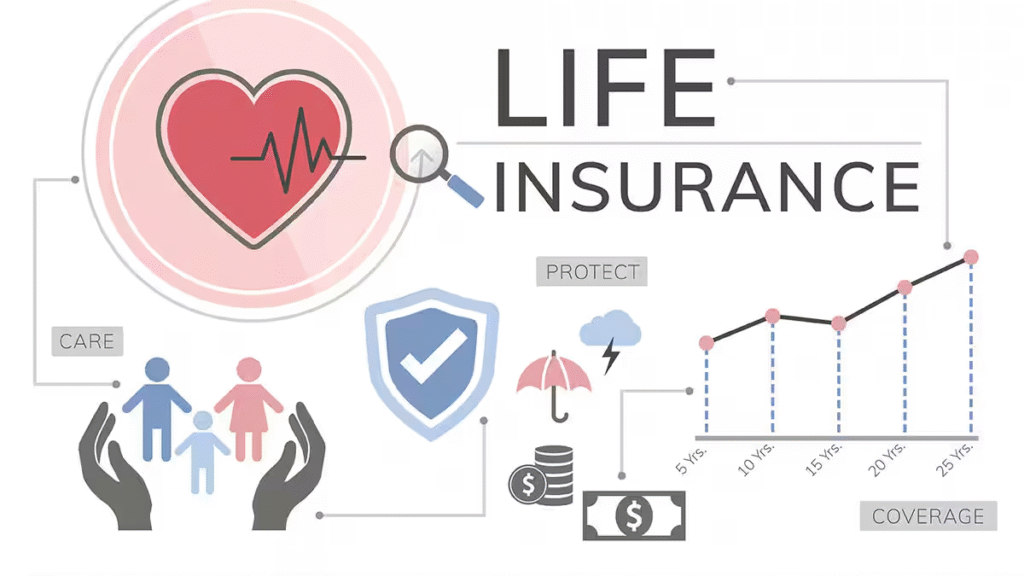Choosing the right life insurance plan is a crucial decision that impacts your family’s financial security and peace of mind. With so many types of life insurance available, understanding the options and determining which plan aligns with your needs, budget, and goals can be challenging. This article aims to guide you step-by-step through the process of selecting the most suitable life insurance policy.
Key Takeaways
- Life insurance is essential for financial protection.
- Term life insurance is affordable and straightforward; permanent insurance builds cash value and lasts a lifetime.
- Calculate coverage based on your income, debts, and future expenses.
- Review your policy regularly and update as your life changes.
- Work with insurance professionals to find the best plan for your needs.
Understanding Life Insurance: The Basic
Life insurance is a contract between you and an insurance company that pays a sum of money to your beneficiaries upon your death. It is designed to provide financial protection and support for your loved ones.
Why Life Insurance Is Important
- Income replacement for your family
- Paying off debts and mortgages
- Covering funeral and medical expenses
- Funding your children’s education
- Providing estate planning benefits
Types of Life Insurance Plans

There are two main categories:
Term Life Insurance
- Provides coverage for a specific period (e.g., 10, 20, or 30 years)
- Lower premiums compared to permanent insurance
- Pays death benefit only if you die during the term
- No cash value accumulation
Permanent Life Insurance
- Lifelong coverage as long as premiums are paid
- Includes a cash value component that grows over time
- Higher premiums than term life
- Types include Whole Life, Universal Life, Variable Life, and Indexed Universal Life
Factors to Consider When Choosing a Life Insurance Plan
Your Financial Goals and Needs
- Determine how much coverage you need by analyzing debts, income replacement, future expenses
- Consider financial obligations like mortgage, education, emergencies
Your Budget
- Understand how much premium you can afford monthly or annually
- Balance between affordable premiums and adequate coverage
Your Age and Health

- Younger, healthier individuals usually pay lower premiums
- Consider underwriting factors and medical exams
Your Family Situation
- Number of dependents
- Spouse’s financial stability
- Future plans (e.g., buying a house, starting a business)
How to Calculate the Right Coverage Amount
- Use “Income Replacement” method: multiply your annual income by the number of years you want to cover
- “Needs-Based” approach: add debts, future expenses, emergency funds
- Online calculators and financial advisors can assist
Comparing Life Insurance Policies
Evaluate Premiums and Payment Terms
When choosing the right life insurance plan, understanding the cost structure and payment options is crucial. Premiums—the amount you pay for your insurance coverage—vary widely based on the type of policy, your age, health, coverage amount, and payment terms. Evaluating these factors carefully helps ensure that your life insurance remains affordable and sustainable over the long term.
- Term life: fixed premiums for the term period
- Permanent life: premiums may increase or be flexible depending on the policy type
Examine Policy Riders and Add-Ons
- Waiver of premium
- Accidental death benefit
- Child riders
- Critical illness coverage
Understand Exclusions and Limitations
When selecting a life insurance policy, it’s essential not only to focus on what the policy covers but also to understand what it does not cover. Every insurance contract contains exclusions and limitations—specific situations or conditions under which the insurer will not pay out the death benefit or may limit the payout. Being aware of these can help you avoid surprises and ensure that your family is truly protected when it matters most.
- Suicide clauses
- Pre-existing conditions
- Coverage lapses
Buying Life Insurance: Step-by-Step
- Assess your needs
- Research and compare policies
- Get quotes from multiple insurers
- Consult an insurance agent or financial advisor
- Complete the application and medical exam (if required)
- Review and finalize your policy
Certainly! Here’s a more detailed and expanded version of When to Review and Update Your Life Insurance Plan with additional insights and examples:
When to Review and Update Your Life Insurance Pla
Your life insurance policy is not a “set it and forget it” financial product. As your life circumstances, financial situation, and goals evolve, so too should your coverage. Failing to periodically review and update your life insurance plan can leave your loved ones underprotected or cause you to overpay for unnecessary coverage. This section delves deeper into the key triggers for reviewing your policy, what to look for during a review, and how to adapt your coverage as needed.
Life-Changing Events That Necessitate an Immediate Review
Major personal milestones often have a direct impact on your insurance needs:
Marriage
Marriage often means combining finances and planning a shared future. Newlyweds usually face new financial obligations such as joint housing costs, debts, and plans for children. You may need to increase your coverage amount to ensure your spouse is financially protected in the event of your untimely death.
Example: Jane, who was single when she bought a $250,000 term policy, married and bought a house with her spouse. They decided to increase her coverage to $500,000 to include mortgage protection and income replacement.
Birth or Adoption of a Child
Adding a child to your family significantly raises your financial responsibilities. Beyond everyday expenses, you may want to plan for education costs, childcare, healthcare, and future weddings. Most experts recommend increasing your life insurance coverage accordingly.
Example: Mark and Lisa reviewed their policy after the birth of their first child and increased their coverage from $300,000 to $700,000 to cover anticipated college tuition and other expenses.
Divorce or Separation
Divorce can dramatically change your financial landscape. It’s critical to update beneficiary designations, adjust coverage levels, and possibly reduce coverage if your obligations have decreased.
Important: Neglecting to update beneficiaries after divorce can result in your ex-spouse receiving the death benefit, which may not align with your current wishes.
Buying a Home or Taking on Major Debt
Mortgage protection is a common reason people purchase life insurance. If you buy a new home or take on significant loans (car, education, business), your coverage should reflect these liabilities.
Career Changes and Income Fluctuations
If you receive a promotion or start earning significantly more, you might need additional coverage to replace your higher income. Conversely, a salary reduction might require adjusting your premium payments or coverage amount to stay within budget.
Regular Scheduled Reviews: Why and How Often?
Even if no major life event occurs, your life insurance should be reviewed every 1 to 3 years. Why?
- Inflation and Cost of Living: Over time, inflation erodes the purchasing power of your death benefit. A $500,000 policy purchased 10 years ago might only be worth $350,000 in today’s dollars.
- Changing Financial Goals: You might decide to save for retirement, help family members financially, or pay off debts earlier, all of which influence your insurance needs.
- Policy Performance: For permanent policies with cash value components, reviewing how your policy is performing is crucial. Some policies may underperform or have increasing costs over time.
- Premium Affordability: Life changes may affect your ability to pay premiums; reviewing your policy allows you to adjust coverage or payment terms.
Updating Beneficiary Information
Life’s changes also affect your beneficiaries:
- New additions to the family such as children or grandchildren.
- Loss of a beneficiary through death or estrangement.
- Legal changes such as creating trusts or naming charitable organizations as beneficiaries.
Failing to update beneficiaries can cause legal complications and unintended distribution of your death benefit.
Exploring New Products and Riders
The insurance industry continuously evolves, introducing new features and riders to address emerging needs. When reviewing your policy:
- Critical Illness Riders: Provide lump-sum payments if diagnosed with certain illnesses.
- Waiver of Premium Riders: Waive premium payments if you become disabled.
- Accelerated Death Benefits: Allow access to a portion of your death benefit if you have a terminal illness.
- Long-Term Care Riders: Help cover nursing or home care expenses.
Evaluating new options can improve your policy’s relevance and value.
Approaching Policy Expiration or Renewal (Term Life Insurance)
Term policies expire after a set period. Before expiration:
- Decide if you want to renew (usually at higher premiums).
- Explore converting term coverage to permanent insurance.
- Consider purchasing a new policy that reflects your current needs.
Impact of Health Changes on Your Policy
Significant changes in health—whether improvements or new medical conditions—can affect your premiums and insurability. Sometimes, a health improvement may qualify you for better rates or a new policy. Conversely, developing chronic illnesses might prompt you to increase coverage before premiums rise.
Financial Windfalls or Losses
Events such as inheritance, selling a business, or incurring large debts impact your overall financial picture and insurance needs. For instance, a large inheritance might reduce the need for coverage, while new debt may increase it.
When to Review and Update Your Life Insurance Plan

Life is dynamic, and so are your financial needs. A life insurance plan that fit your circumstances a few years ago might no longer provide adequate protection today. Regularly reviewing and updating your life insurance ensures that your policy continues to align with your current situation and goals.
Major Life Events
Certain key events should prompt an immediate review of your life insurance coverage:
- Marriage or Divorce:
Getting married often increases financial responsibilities and may require more coverage. Conversely, divorce may change beneficiary designations and affect your insurance needs. - Birth or Adoption of a Child:
Welcoming a new child increases your family’s financial needs, including education, childcare, and future living expenses, often requiring higher coverage. - Buying a Home:
Taking on a mortgage is a significant liability. Ensuring your policy covers your home loan protects your family from losing the house if you pass away. - Starting a Business:
New financial risks and obligations mean reassessing your life insurance to cover business debts or protect partners. - Change in Employment or Income:
Promotions, job changes, or loss of income can impact your coverage needs and premium affordability. - Health Changes:
Improved health might qualify you for lower premiums, while new health issues may require reassessing your policy or coverage amounts.
Periodic Policy Review
Even without major life changes, it’s wise to review your life insurance every 1 to 3 years. Consider:
- Coverage Adequacy:
Inflation, increased living costs, and changes in your family’s lifestyle can erode the real value of your coverage over time. - Policy Performance (for Permanent Insurance):
If you hold permanent life insurance, monitor your policy’s cash value growth and ensure it aligns with your expectations and needs. - Premium Affordability:
Changes in your budget might require adjustments to premium payments or policy features.
Changes in Beneficiary Designations
Ensure your beneficiary information reflects your current wishes, especially after:
- Marriages, divorces, or remarriages
- Birth or adoption of children
- Death of a beneficiary
- Changes in family dynamics or trust arrangements
New Insurance Products or Options
The insurance market evolves, and newer products or riders might better suit your needs. During reviews, explore:
- New riders for critical illness, disability, or long-term care
- Conversion options from term to permanent insurance
- More affordable or flexible policies
Policy Renewal or Expiry (Term Insurance)

If you hold a term life policy, review it as the term nears expiration. Options include:
- Renewing the policy (likely at higher premiums)
- Converting to a permanent policy
- Purchasing a new policy with updated coverage
- After major life changes: marriage, birth of a child, divorce
- When financial situations change
- Periodically every few years to adjust coverage
Also read: What Is the Best Business Insurance Policy for Your Company?
Conclusion
Choosing the right life insurance plan requires careful evaluation of your personal circumstances, financial goals, and available options. By understanding the differences between term and permanent insurance, assessing your coverage needs, and working with trusted advisors, you can secure a policy that protects your family’s future with confidence.
Choosing the right life insurance plan is one of the most important financial decisions you can make to protect your loved ones and secure their future. While the variety of insurance products available may seem overwhelming, understanding the core differences between term and permanent life insurance, carefully assessing your personal and financial situation, and clearly defining your coverage needs will guide you toward the best policy.
It’s essential to consider factors such as your age, health, family responsibilities, and long-term financial goals when selecting coverage. Additionally, reviewing policy details—such as premium costs, riders, exclusions, and flexibility—ensures that you get a plan that not only fits your budget but also provides adequate protection.
Remember that life insurance isn’t a “set it and forget it” product. Your needs will evolve over time with life events such as marriage, the birth of children, home purchases, or career changes. Regularly reviewing and updating your coverage ensures that your policy continues to meet your family’s needs
Frequently Asked Questions (FAQs)
What is the difference between term and permanent life insurance?
Term covers a specific period with no cash value; permanent lasts a lifetime and builds cash value.
How much life insurance do I need?
It depends on your debts, income replacement needs, and future financial goals.
Can I convert term life insurance to permanent?
Many term policies offer conversion options during the term.
Are life insurance premiums tax-deductible?
Generally, premiums are not deductible, but death benefits are usually tax-free.
Does life insurance cover suicide?
Most policies have a suicide exclusion period, typically two years.
Can I have more than one life insurance policy?
Yes, many people hold multiple policies for different needs.
What happens if I miss a premium payment?
You may have a grace period to pay before the policy lapses.


